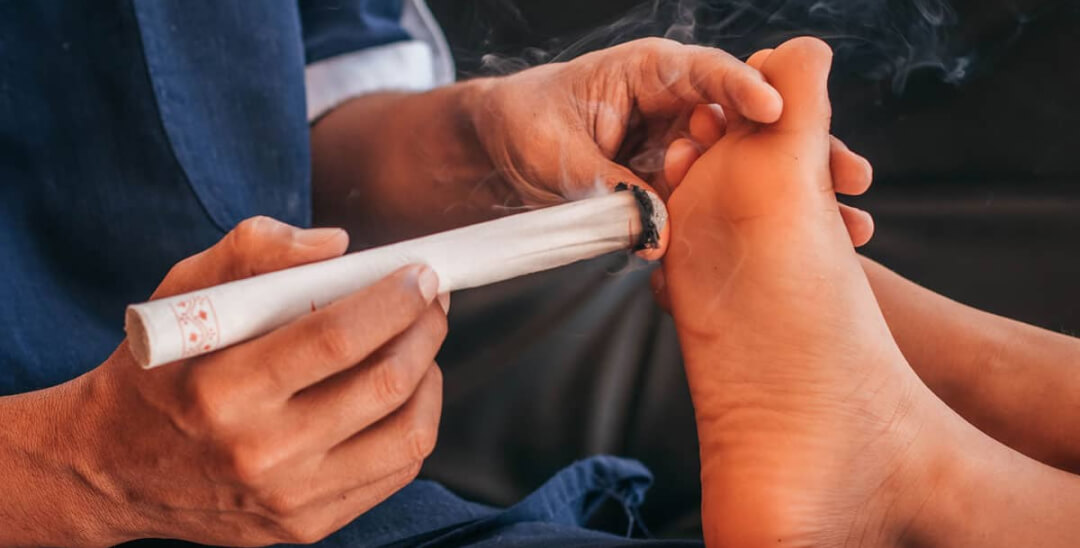How Moxibustion Addresses Knee Pain
For those who suffer from knee pain and other joint-related issues, finding relief often comes in the form of pain medication such as Tylenol or Ibuprofen. Unfortunately, these options come with a host of flaws. For example, painkillers only temporarily relieve pain, and doctors often have to increase the dose if the original dose is no longer working for patients. This happens quite frequently as patients can build up a tolerance to the medication. In addition to this, there are some concerning side effects associated with painkillers, like stomach and liver damage. All in all, treating pain with any form of medication comes at a cost. Thankfully, there is an alternative solution that does not use prescribed medications in applying pain relief: moxibustion.
What is Moxibustion?
Moxibustion is a treatment that involves the burning of moxa, which are dried materials found in the Chinese mugwort or Artemisia. This is a flowering plant that is part of the daisy family. It is used in foods that are consumed around the world which includes countries such as Japan, Korea, and even Germany.
This form of treatment originated in China around 2,500 years ago. Over the centuries, moxibustion has been used to treat a wide range of illnesses and ailments. It was even popular in Europe during the 17th century when new methods were introduced. However, the practice of moxibustion in Western culture subsided and was not rediscovered until centuries later.
How is Moxibustion Utilized?
The process itself is quite simple. The herb is placed on the skin either on or near a specific acupuncture point. The mugwort is then burned to release its properties into the skin. This is the direct approach when using moxa to treat various conditions. The burning creates a warming sensation that helps the blood to flow better through the body. Once most of the moxa has been burned away, the herb is removed before it can cause any damage to the skin.
The indirect approach involves placing a slice of garlic, ginger, or other substance on the skin first, then placing the moxa on top of the substance. This means that there is no direct contact with the moxa to the skin. One of the most common moxibustion treatments uses a moxa stick which contains the moxa while it is being burned. The indirect approach is the more common of the two because it reduces the chances of accidental burning while still delivering the benefits that moxibustion provides.
The Many Benefits of Moxibustion
External Use
Another positive is that the effect is created without ingesting a product. Instead, the pain itself is reduced thanks to the heat generated by the moxa. This means that if you are using medications, it should not cause an unwanted interaction. However, you should consult with your doctor about all treatments that you are using, which include moxibustion.
Time Tested
Being time-tested is another positive for moxibustion. For over 2,500 years, it has been in use in China and many parts of the world. This means that the experimentation process has whittled down the treatments to where they best apply. The relief of knee pain, along with other joint pain, has survived because it has a track record of success.
Pain Relief for the Joints
Moxibustion treatments increase the flow of blood along with the Qi, which is part of the energy centers in the body. For joint pain, the increase in blood flow using the moxibustion method combined with the heat provides proven pain relief that is natural and without the use of pain medications.
The pain that is caused in the knees is often attributed to the accumulation of cold and dampness, particularly during the colder months of the year. The wear and tear on your knees over time makes them more subject to the pain associated with the reduced temperature and increase in moisture, which helps conduct the cold. Moxibustion expels the cold and reduces moisture which in turn helps relieve the pain.
The increase in blood flow also promotes faster healing. This means that your knees can recover from the stress of jogging, running, or even walking over distances at a faster rate. For those who suffer from knee pain along with shoulder, abdominal, or other joints in the body, moxibustion does provide relief.
In addition to treating joint pain, moxibustion is used to treat the following conditions:
- Gastrointestinal Issues
- Indigestion
- Infertility
- Menstrual Cramps
- Organ Prolapse
Are There Any Negatives to Using Moxibustion?
The unwanted side effects of moxibustion are few and far between. The most common is leaving the moxibustion on the skin too long, which causes a burning sensation along with potential damage. However, the warming sensation does become more acute, which provides a warning before any damage to the skin can take place.
Other risks include allergic reactions to the mugwort, a sensitivity to the smoke that is generated during the treatment, and if you have asthma or other respiratory conditions, you might be subject to an unwanted side effect of the treatment. For most people, moxibustion is a safe, effective treatment. Especially when the indirect method is used, and the skin is protected so that no direct contact is made and when the right techniques are applied.
Is Moxibustion a Beneficial Treatment?
Moxibustion has proven to be an effective treatment when used properly. This means that if you are seeking an alternative to pain medications, moxibustion may be the answer. It is safe, easy to apply, and provides natural relief that uses the body itself to help reduce the pain. Interestingly enough, when compared to acupuncture, moxibustion treatment has been proven as more effective when it comes to treating knee pain.
How to Get Started with Moxibustion
It is recommended that if you are interested in trying out the treatment for yourself, you first seek out a trusted practitioner who has the training and skill to perform it properly. If you already receive acupuncture treatments, then ask if the acupuncturist can perform moxibustion or if they can recommend someone who can. Combining moxibustion with acupuncture treatments may enhance pain relief.
If you cannot find a professional practitioner in the area, you can perform the treatment yourself if you use the proper products and techniques. A moxa stick or similar product is designed for self-treatment.
Steps for Performing Moxibustion at Home
To perform moxibustion at home, you should follow the instructions provided with the product. A moxa stick, for example, can be used in the following way.
Ignite the end of the stick using a lighter, match, or candle. Hold the lit part of the stick over the area that you want to treat, but do not touch the skin. Instead, keep the lit part of the stick about one inch over the skin. Close enough to feel the heat, but not enough to cause any burning.
Move the moxa stick in small circles above the area and remove it when it feels too hot. The goal is to repeat the treatment with a single stick for about five to seven minutes. When completed, it is advised not to take a bath or shower for at least four hours. This allows the heat from the treatment to continue working.
Final Thoughts
Moxibustion is a safe, effective alternative means of treating knee pain along with a variety of other conditions. You might just find that moxibustion can be the primary method of treating your knee pain when used properly.
Keywords: Moxibustion, Treating knee pain, Natural relief, Moxa stick, Moxibustion treatments
References:
https://pubmed.ncbi.nlm.nih.gov/29775226/
https://www.takingcharge.csh.umn.edu/moxibustion
https://vuim.edu/moxibustion-in-acupuncture-history-uses-benefits-cautions/


